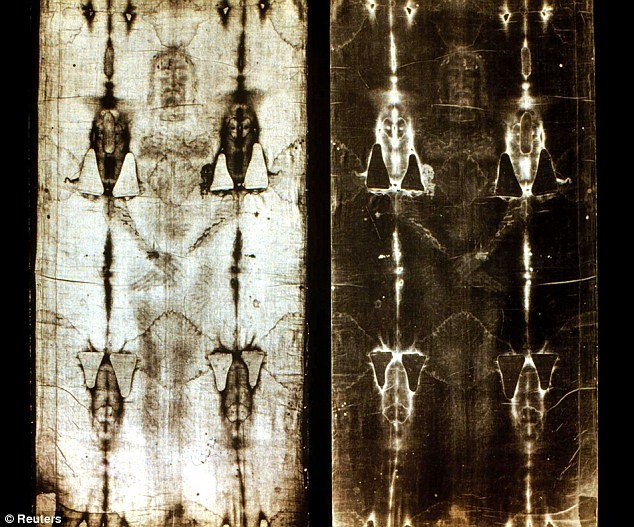
A group of Italian scientists say that the Shroud of Turin could actually be Christ’s burial robe despite years of tests proving the contrary.
Using a series of advanced experiments, Italian researchers say that the technology available when it was created was simply not available to likely “fakers”- and that marks on the shroud were created by a blinding flash of light at short wavelengths.
Carbon dating tests carried out in 1988 in Oxford, Zurich and Arizona suggested that the shroud was created some time between 1260 and 1390.
That research was disputed, however, because there was a possibility of contamination from patches of cloth that had been sewn on following a fire in Chambery, France, in 1532.
Burn marks sustained during the fire are visible along the edges of the shroud where molten silver dripped onto the cloth and in a series of triangular patches on both sides of the piece.
Theologians have suggested that the shroud, which is stored in the royal chapel at the Cathedral of St John the Baptist in Turin, was created when Jesus was resurrected.
Scientists from the National Agency for New Technologies, Energy and Sustainable Development tried to recreate the piece, but found that they could only do so with advanced machinery, according to the Daily Telegraph.

Intense beams of UV light were fired at a piece of cloth but when they were unable to recreate the marks on the shroud they concluded that “some form of electromagnetic energy (such as a flash of light at short wavelength)” must have created the image.
Professor Paolo Di Lazzaro said: “When one talks about a flash of light being able to colour a piece of linen in the same way as the shroud, discussion inevitably touches on things like miracles and resurrection.”
Professor’s report states that: “The double image (front and back) of a scourged and crucified man, barely visible on the linen cloth of the Shroud of Turin, has many physical and chemical characteristics that are so particular that the staining… is impossible to obtain in a laboratory.”
Rather than offering a non-scientific explanation, however, Prof. Paolo Di Lazzaro continued: “We hope our results can open up a philosophical and theological debate but we will leave the conclusions to the experts, and ultimately to the conscience of individuals.”
In 2009 it was claimed that Leonardo da Vinci had created the image and it could even have been a self-portrait.
Lillian Schwartz, a graphic consultant at the School of Visual Arts in New York, claims that the image is a self-portrait, which was made using a crude photographic technique.
Using computer scans she found that the face on the Turin Shroud and a self portrait of Leonardo da Vinci share the same dimensions.
Earlier this year an Italin art expert Luciano Buso suggested that the 14 ft length of fabric was made by medieval artist Giotto.
What is the Turin Shroud?
The Vatican owns the Turin Shroud, and hails the relic as an exploration of the “darkest mystery of faith”.
But the church has shied away from any definitive statement over whether the shroud – which is supposed to have formed Christ’s burial robe – is real.
The Shroud is thought to have travelled widely before it was brought to France in the 14th century by a Crusader.
The Shroud was kept in a French convent for years – by nuns who patched it, and where it was damaged by fire.
It was given to the Turin Archbishop in 1578 by the Duke of Savoy and has been kept in the Cathedral ever since.
Carbon dating tests in 1988 dated it from between 1260 and 1390 – implying it was a fake.
Scientists have since claimed that contamination over the ages from patches, water damage and fire, was not taken sufficiently into account.
In 1999, two Israeli scientists said plant pollen found on the Shroud supported the view that it comes from the Holy Land.
There have been numerous calls for further testing but the Vatican has always refused.
[youtube 0FxNKKlKhkk]